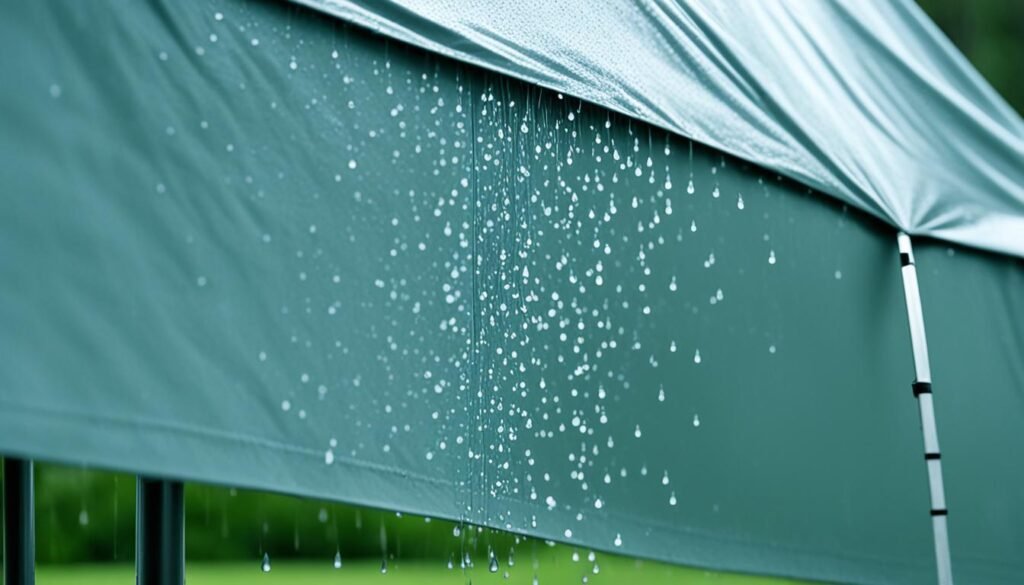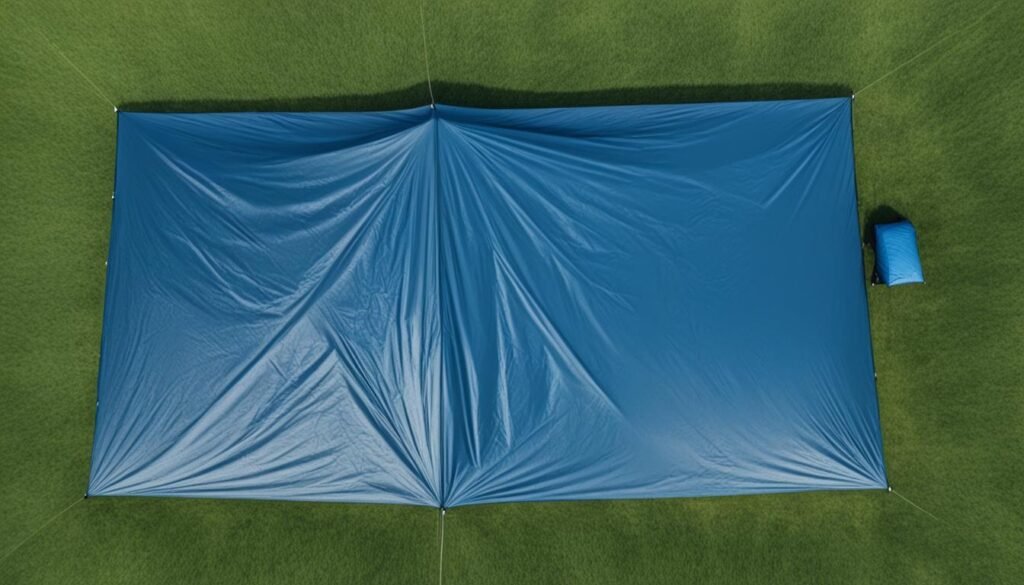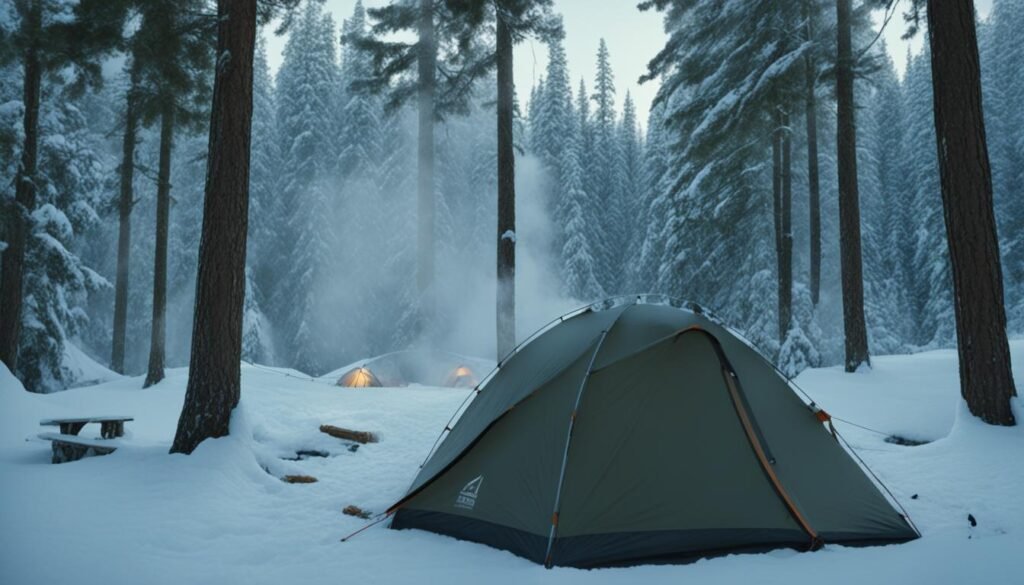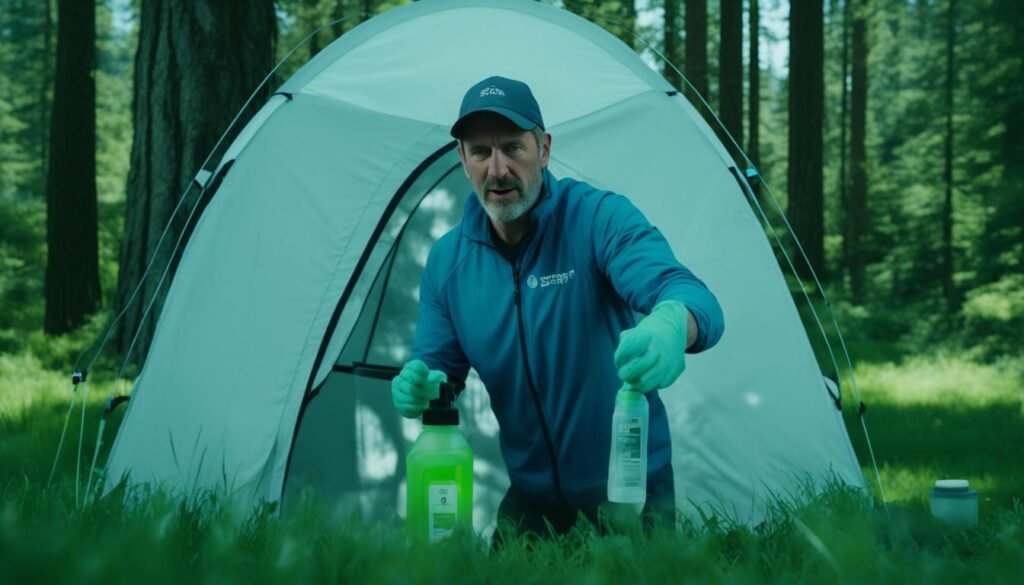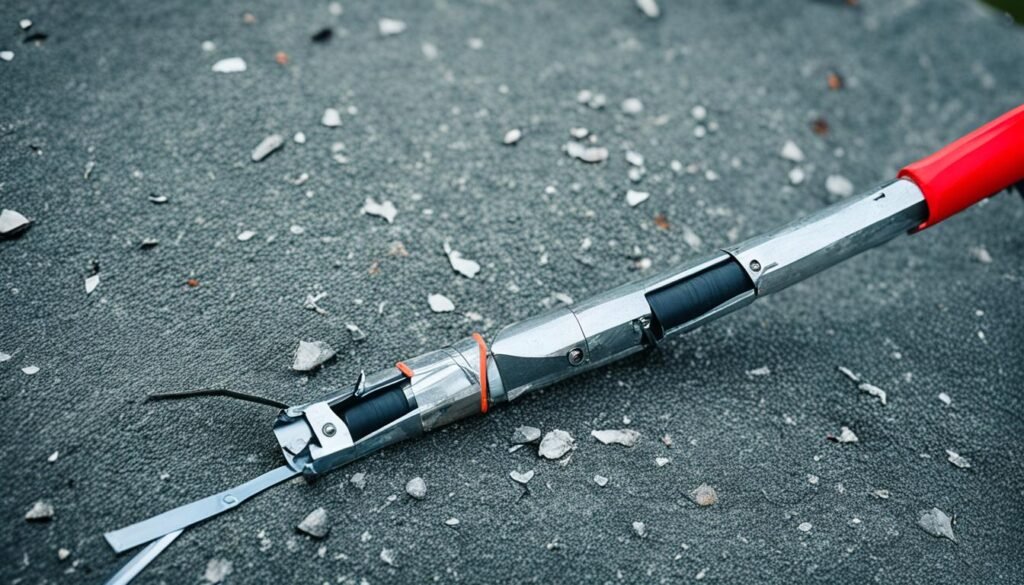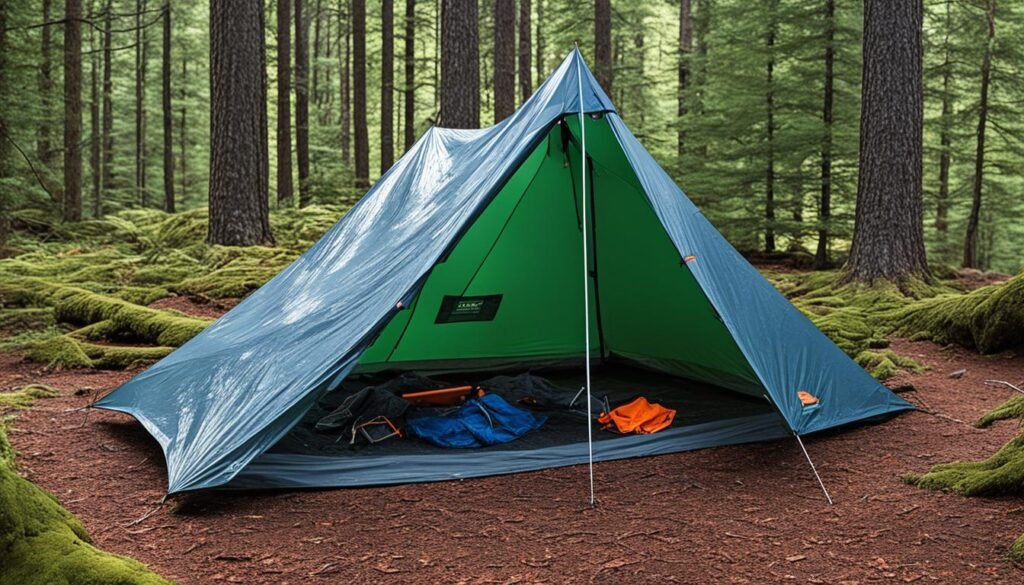Camping in the rain can be an exciting adventure, but it requires careful preparation to ensure a dry and comfortable experience. Whether you’re a seasoned camper or a first-timer, knowing how to set up your tent for rain is essential. In this section, I will provide you with expert tips and strategies to help you create a rainproof tent setup.
Key Takeaways:
- Using a groundsheet or tent footprint is crucial for keeping your tent dry.
- Tarps can provide additional rain protection by creating a tarp roof above your tent.
- Consider your campfire setup and have a backup cooking method in case of heavy rain.
- Pay attention to the angles when setting up your tent and campfire to prevent water infiltration.
- If traditional tent camping is not your preference, hammock camping can be a great alternative for wet conditions.
Don’t Forget Your Groundsheet
In order to keep your tent dry during rainy conditions, one essential item you should never forget is a groundsheet. Acting as a protective barrier between your tent and the wet ground, a groundsheet prevents water from seeping inside and ensures a dry and comfortable camping experience.
When choosing a groundsheet, opt for a waterproof material that will effectively repel water. Alternatively, you can use a larger tarp as a substitute for a groundsheet, as long as it covers the entire area beneath your tent.
A reliable groundsheet or tarp plays a vital role in creating a waterproof foundation for your tent, preventing moisture from soaking through the tent floor and keeping you dry even in heavy rain.
| Benefits of Using a Groundsheet |
|---|
| 1. Protects the tent floor from punctures and abrasions caused by rocks, roots, and other debris. |
| 2. Provides an additional layer of insulation. |
| 3. Prevents moisture buildup, condensation, and dampness inside the tent. |
| 4. Reduces the risk of mold and mildew growth. |
Remember: A groundsheet is an essential camping accessory that helps maintain a dry and comfortable sleeping area.
Expert Tip:
“Using a groundsheet or a larger tarp beneath your tent not only keeps you dry but also helps protect the longevity of your tent by preventing damage and maintaining its waterproof integrity. Don’t overlook the importance of this simple yet effective tool.”
By ensuring you have a high-quality groundsheet or a suitable substitute, you can confidently face rainy camping conditions while keeping your tent dry and comfortable.
Tarp Up
Tarps are versatile camping essentials that can be used to create additional rain protection. Whether you’re dealing with unexpected showers or planning for wet weather, using tarps is an effective way to keep your campsite dry.
One strategy is to string up an extra tarp roof above your tent using paracord or lightweight camping poles. This provides an additional layer of protection against rain, preventing water from seeping through your tent’s roof.
Pro tip: Angle the tarp slightly to ensure proper water runoff and minimize the risk of water pooling on top of your tarp roof.
It’s essential to secure the tarp tightly using guylines, stakes, or other secure fastenings. This prevents wind from catching the tarp and potentially causing damage or compromising its effectiveness in keeping rain out.
By tarping up, you can create a reliable rain shelter and enhance your camping experience even in inclement weather.
Additional Rain Gear
In addition to using tarps, it’s essential to have proper rain gear on hand when camping in wet conditions. This includes waterproof clothing such as rain jackets, pants, and sturdy footwear. Investing in high-quality rain gear will keep you dry and comfortable throughout your camping trip.
Remember, cotton clothing retains moisture, so opt for quick-dry synthetic or wool layers instead. These materials wick away moisture, keeping you warmer and drier in wet conditions.
Consider Your Campfire
When camping in the rain, a reliable campfire can provide much-needed warmth and comfort. To ensure a steady heat source even during inclement weather, it’s best to start your campfire before it starts raining. This way, you can enjoy the cozy ambiance and the practical benefits of a roaring fire even if the rain intensifies later.
However, it’s essential to take precautions to protect your campfire and cooking area from the rain. Setting up tarps near the campfire area provides additional shelter, creating a dry space where you can cook your meals. This rainproof cooking area not only keeps you dry but also prevents moisture from extinguishing your firewood.
Note the importance of proper fire safety measures when using tarps near an open flame. Ensure that the tarps are positioned securely and allow for sufficient ventilation. Always monitor your fire and make sure it is fully extinguished before leaving the area.
Additionally, it’s wise to have a designated area for firewood storage that’s protected from the rain. Stack firewood under a tarp or in a covered storage container to keep it dry and easily accessible. Keeping your firewood dry ensures that you have the necessary fuel for a sustained fire, even as the rain persists.
If the rain becomes too heavy or the conditions make it difficult to maintain a campfire, having a camping stove as a backup is a wise investment. A camping stove allows you to enjoy the comfort of a hot meal without the hassle of wet firewood. It provides a convenient alternative for cooking and boiling water, ensuring that you can still enjoy delicious meals in the great outdoors, regardless of the weather conditions.
Remember to always follow local regulations and guidelines when using open flames or camping stoves in your camping area.
| Method | Pros | Cons |
|---|---|---|
| Using tarps to create a rainproof cooking area | – Provides dry space for cooking – Protects firewood from rain and moisture |
– Requires proper setup and monitoring – Safety concerns due to close proximity to flames |
| Camping stove | – Convenient and easy to use – Provides consistent heat source – No need for dry firewood |
– Requires additional equipment – Limited cooking capacity compared to campfire |
Angle for the Weather
When it comes to camping in rainy conditions, paying attention to the angles of your tent setup and campfire can make a significant difference in your overall camping experience. By making a few strategic adjustments, you can ensure better protection from the elements and a more enjoyable camping trip.
Setting up your Tent
When choosing a spot to set up your tent, consider the slope of the ground. It’s ideal to set up your tent on a slight slope to allow water to flow by instead of pooling underneath. This will help prevent water from seeping into your tent and keep you dry throughout your camping adventure. Additionally, avoid camping close to bodies of water that may flood during heavy rain to prevent any potential water damage.
Angling your Campfire
An important aspect of campfire setup is angling it away from the wind direction. By positioning your campfire at an angle, you can minimize the risk of wind blowing sparks towards your tent or campsite, reducing the chances of damage or accidents. This is especially important during rainy conditions when a gust of wind can easily extinguish your fire and leave you without a heat source. Taking the time to find a sheltered spot or using natural windbreaks, such as trees or rocks, can further protect your campfire.
Remember:
Setting up your tent on a slight slope will allow water to flow by instead of pooling underneath, ensuring a dry and comfortable camping experience. Angling your campfire away from the wind will prevent damage and keep your fire burning strong.
By considering the angles of your tent setup and campfire during rainy conditions, you can make your camping trip more enjoyable and worry-free. Next, let’s explore the benefits of hammock camping and how it can offer a dry and comfortable alternative to traditional tent camping.
Hammock Camp
When it comes to camping in wet conditions, hammock camping can be a game-changer. Instead of setting up a traditional tent on the damp ground, try using a hammock. Not only does this keep you elevated and dry, but it also provides a unique and comfortable camping experience.
Start by choosing a sturdy hammock that is designed for camping. Look for models that are made from durable materials and have a high weight capacity. Consider investing in a hammock with an integrated bug net and rainfly for added protection against insects and rain.
Once you have your hammock, find a suitable location to set it up. Look for two sturdy trees or other anchor points that are a suitable distance apart. Make sure the trees are strong enough to support your weight and the weight of your gear.
To make your hammock camping experience even more rain-prepared, set up a tarp above your hammock. This will provide additional rain protection and help keep you dry. Secure the tarp with paracord or lightweight camping poles, making sure it is angled properly to allow for water runoff. With the tarp in place, you can relax in your hammock and enjoy the sound of rain without getting wet.
In addition to keeping yourself dry, it’s important to also protect your gear from the rain. Utilize a line or paracord to hang your gear underneath the tarp, keeping it off the ground and away from potential water damage. This method is particularly useful for kayaking trips or camping in flood-prone areas where the ground may be wet or underwater.
So next time you embark on a camping trip in wet conditions, consider ditching the tent and opting for a hammock instead. Not only will you stay dry and comfortable, but you’ll also enjoy the unique experience of hammock camping. Just remember to set up a tarp for extra rain protection and to hang your gear safely underneath.
“Hammock camping not only keeps you above the wet ground but also offers a superior sleeping experience. It’s like being cradled by nature while enjoying the soothing sound of raindrops.”
Hammock Camping Tips:
- Choose a hammock made from durable materials and designed for camping
- Find two sturdy anchor points, such as trees, for setting up your hammock
- Add a rainfly or tarp above your hammock for additional rain protection
- Use paracord or lightweight camping poles to secure the tarp
- Hang your gear underneath the tarp using a line or paracord
Store Your Gear in Dry Bags
When camping in wet conditions, keeping your belongings dry is essential. That’s where dry bags come in. These waterproof bags are a must-have for any camper, providing reliable protection for your clothes, electronics, and other essential items. With a large, well-made dry bag, you can have peace of mind knowing that your gear will stay dry throughout your camping trip.
Dry bags are designed to be completely waterproof, keeping out moisture even in heavy rain or when submerged in water. They are made from durable materials such as PVC or nylon, with watertight closures like roll-tops or zipper seals. The waterproof construction and secure closure ensure that no water can penetrate the bag, providing maximum protection for your belongings.
Available in various sizes and styles, dry bags offer versatile storage options for all your camping gear. Whether you need a small bag for your phone and wallet or a larger bag for your clothes and electronics, there’s a dry bag to suit your needs. Some dry bags even come with shoulder straps or backpack-style straps for convenient carrying.
When packing your gear in dry bags, it’s important to organize them properly. Use smaller dry bags or packing cubes to categorize your items and keep them easily accessible. This will prevent you from rummaging through the bag and exposing other items to moisture.
Additionally, you can use dry bags with different colors or labels to further organize and identify your gear. This makes it easier to find specific items without having to empty the entire bag.
Pro Tip: Consider using different sizes and colors of dry bags to separate and organize your gear, making it easier to find what you need without exposing everything to the elements.
When choosing dry bags, it’s important to invest in quality. Look for brands that are known for their durability and reliability. Popular outdoor brands like Sea to Summit, Outdoor Research, and Osprey offer a wide range of high-quality dry bags that are designed to withstand the rigors of camping and outdoor activities.
Remember, having reliable gear storage is crucial for protecting your camping essentials. Investing in quality dry bags is a smart choice that will ensure your gear stays dry, even in the rainiest conditions.
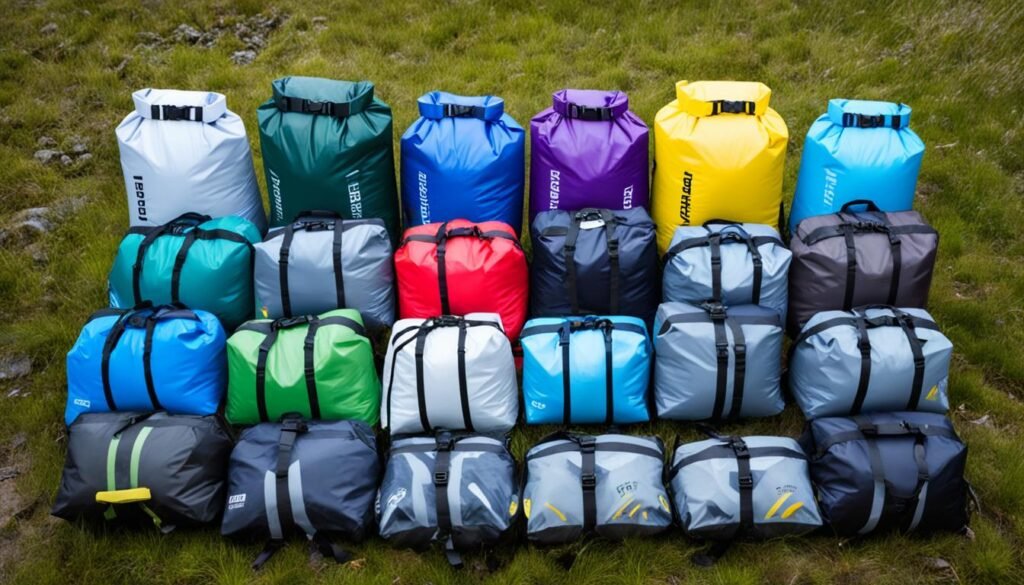
Stay tuned for Section 8, where I’ll share tips on choosing the right rain gear for your camping adventure.
Use Quality Rain Gear
When it comes to venturing into the great outdoors, unpredictable weather can be a challenge. However, with the right camping rain gear, you can stay dry and comfortable even in the heaviest downpour. Investing in high-quality waterproof clothing is essential for a successful camping trip in the rain.
First and foremost, make sure to have a reliable rain jacket that will keep you protected from the elements. Look for a jacket that is specifically designed for outdoor activities and features waterproof and breathable materials. This will ensure that you stay dry from both the rain and any perspiration that may occur during physical activities.
In addition to a rain jacket, waterproof pants are also a must-have item for any camper. Opt for pants that are made with durable and waterproof materials, ensuring they can withstand prolonged exposure to rain. These pants will provide an extra layer of protection against moisture, preventing discomfort and allowing you to fully enjoy your camping experience.
When selecting rain gear, it’s important to remember that cotton clothing retains moisture and can leave you feeling damp and cold. Instead, choose quick-dry synthetic or wool layers that will wick away moisture and keep you warm even in wet conditions.
Remember, quality rain gear is an investment that will pay off in the long run. By choosing reliable and durable waterproof clothing, you can enjoy your camping trip without worrying about getting soaked. Stay dry, stay comfortable, and make the most of your rainy camping adventure!
Gear and Prep
When camping in wet weather, it’s essential to prepare your gear to withstand the rain. This section will guide you on the key steps to ensure your camping gear is ready for the elements.
Invest in a Waterproof Tent
One of the most crucial pieces of gear for wet weather camping is a high-quality waterproof tent. Look for tents made with waterproof materials and sealed seams to effectively keep the rain out. A well-designed tent will provide reliable protection, ensuring a dry and comfortable camping experience. Remember to choose a tent size that accommodates your group and gear appropriately.
Consider Tent Seasoning
To further enhance the waterproofing capabilities of your tent, consider seasoning it before your camping trip. Tent seasoning involves applying a waterproof coating or seam sealant to the tent fabric, creating an additional barrier against water seepage. Follow the manufacturer’s instructions on how to properly season your tent to maintain its waterproofing and extend its lifespan.
Maintain and Inspect Your Tent
Prior to your camping trip, thoroughly inspect your tent for any damage, such as tears, holes, or broken zippers. Repair any issues promptly to ensure your tent remains watertight. Additionally, check the guylines and stakes to ensure proper stability, especially in windy conditions. Securely stake down your tent to prevent it from shifting or collapsing during rain or strong winds.
Be Prepared with Guylines
Guylines are essential for stabilizing your tent and providing additional resistance against wind and rain. Properly set up and tension your guylines to ensure your tent stays securely in place. Consider using reflective guylines to improve visibility during nighttime or low-light conditions.
Waterproof Tent Brands Comparison
| Brand | Features | Price Range |
|---|---|---|
| Brand A | Sealed seams, durable materials | $200 – $400 |
| Brand B | Easy setup, spacious interior | $150 – $300 |
| Brand C | Lightweight, compact design | $100 – $250 |
Investing in a high-quality waterproof tent and properly preparing it for rain will help ensure a dry and comfortable camping experience. Don’t forget to inspect and maintain your tent regularly to keep it in excellent condition for future adventures.
Proper Site Selection
When it comes to camping in the rain, selecting the right campsite is essential to ensure a dry and comfortable experience. Here are some factors to consider for proper site selection:
Water Drainage
To prevent water from creeping into your tent, choose a campsite with good water drainage. Avoid low spots where water could collect and potentially flood your tent. Look for slightly elevated areas where water can flow away from your sleeping area.
Natural Shelter
Utilizing natural shelter can provide additional rain protection for your campsite. Trees can act as a natural canopy, shielding your tent from heavy rainfall. However, be cautious of standing dead trees that could pose a risk in strong winds. Select healthy, sturdy trees that can provide reliable shelter.
“Choosing the right campsite with proper water drainage and natural shelter can make a significant difference in your camping experience during rainy weather.” – Expert Camper
By carefully considering campsite selection, you can minimize the risk of water seeping into your tent and ensure a more enjoyable camping adventure, even in wet conditions.
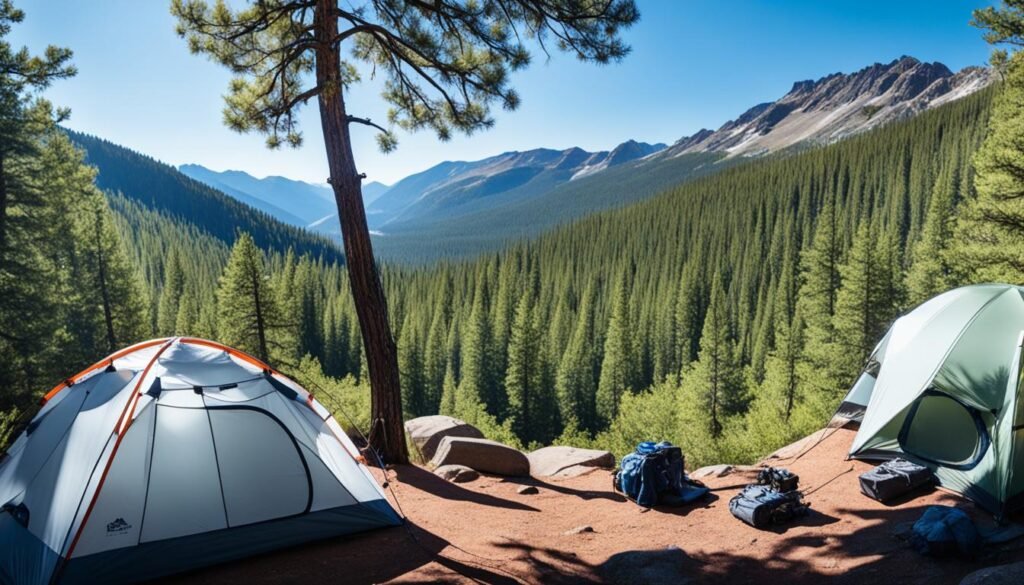
Keep Everything Dry
When camping in the rain, it’s essential to keep your gear and surroundings as dry as possible. Here are some tips to help you achieve that:
Pack Absorbent Materials
To prevent surfaces from getting wet, pack extra towels and absorbent materials. These can be used to wipe off excess moisture from camping equipment, seating areas, or even the inside of your tent. Place them strategically to absorb any water that may collect.
Utilize Waterproof Bags and Tarps
One of the best ways to protect your gear from rain is by using waterproof bags and tarps. These can create an additional layer of protection, keeping your belongings dry even in heavy downpours. Make sure to seal the bags properly and secure the tarps tightly to prevent any leaks or water seepage.
Collect Water Runoff
Instead of letting water pool around your campsite, consider using a plastic container to collect the water runoff. This prevents the area from becoming muddy and helps maintain a clean outdoor space. Additionally, it reduces the risk of potential water damage to your gear.
Dry Wet Gear
In wet conditions, drying wet gear is crucial to prevent moisture from lingering and causing mold or unpleasant odors. Hang up wet clothing, towels, and other damp items to dry. Take advantage of any breaks in the rain to air out your belongings.
Prepare Rainy Day Activities
It’s always a good idea to have rainy day activities planned to keep everyone entertained during inclement weather. Pack board games, cards, or books that can be enjoyed inside your dry tent or under a tarp shelter. Staying occupied ensures a positive camping experience even when the rain persists.
| Absorbing Materials | Waterproof Bags | Water Collection |
|---|---|---|
| Extra towels | High-quality dry bags | Plastic container for water runoff |
| Absorbent mats | Waterproof stuff sacks | |
| Camp towels | Waterproof backpacks |
Check the Weather
Before embarking on your camping trip, it’s essential to stay informed about the weather forecast. Knowing what to expect will help you plan and prepare accordingly, ensuring a successful and enjoyable outdoor adventure.
- Keep an eye on the weather forecast in the days leading up to your trip.
- Check for updates closer to your departure date to ensure you have the most accurate information.
- Pack appropriate clothing and gear based on the expected weather conditions.
By staying proactive and informed about the weather, you can make the necessary preparations to mitigate the impact of rain and ensure a memorable camping experience.
Prepare for Rain
When the forecast indicates rain, it’s crucial to be prepared. Here are a few tips to help you get ready:
- Invest in quality rain gear: A waterproof jacket, pants, and boots will keep you dry throughout your camping trip.
- Pack rainproof equipment: Ensure your tent, tarps, and camping gear are designed to withstand wet conditions.
- Have backup activities: Plan alternative activities that can be enjoyed indoors or under cover, such as board games or storytelling sessions.
By taking the necessary precautions and having backup plans in place, you can minimize the impact of rain and make the most of your camping experience.
Remember, there’s no such thing as bad weather, only unsuitable clothing and poor preparation.
Stay Flexible
While it’s essential to plan ahead, it’s also important to be flexible and adapt to the weather conditions. Here are a few tips:
- Adjust your itinerary: If heavy rain is expected, consider shortening or altering your hiking routes to avoid challenging terrain.
- Embrace indoor activities: Use rainy days as an opportunity to explore nearby towns, museums, or attractions.
- Stay positive: Don’t let the rain dampen your spirits. Instead, embrace the unique atmosphere and enjoy the beauty of nature in the rain.
By maintaining a positive mindset and adjusting your plans when necessary, you can still have a rewarding camping experience, even in unfavorable weather conditions.
Stay Positive
While camping in the rain may not be what you expected, maintaining a positive mindset can turn a wet experience into an invigorating adventure. Embrace the rain and take the opportunity to appreciate the unique beauty it brings.
Despite the challenges that a rainy camping trip may present, there are countless opportunities to make the most of your experience. Pay attention to the details of nature that stand out in the rain, such as the soothing sound of raindrops on leaves or the vibrant colors that come to life in a wet environment.
Remember, camping is all about connecting with nature, and rain is just one element that nature has to offer. Whether it’s the fresh scent of damp earth, the beauty of rainbows after a storm, or the cozy feeling of being bundled up in your tent, there are countless reasons to appreciate the rain.
So, instead of letting the rain dampen your spirits, embrace it as part of the adventure. Use the rainy weather as an opportunity to cozy up with a good book, engage in meaningful conversations with family and friends, or simply enjoy the peacefulness and solitude that rainy camping trips often bring.
By adopting a positive mindset and embracing the rain, you can transform what may seem like a setback into a memorable and enriching camping experience.
Pack Up!
When it’s time to leave your campsite, efficient packing is essential, particularly if you’re dealing with rain. Follow these tips to ensure a smooth and organized departure, while protecting your gear from the elements.
1. Take down the main shelter last
Start by dismantling all other camping equipment and gear before taking down the main shelter, whether it’s a tent, tarp, or hammock. This strategy will provide temporary shelter while you pack up the remaining items, minimizing the risk of getting wet in the rain.
2. Keep gear dry and organized
As you pack, prioritize keeping your gear dry and organized. Place items inside waterproof bags or wrap them in waterproof covers to protect them from rain and moisture. Utilize separate bags or containers for different categories of gear, such as clothes, cooking equipment, and electronics, to stay organized and easily locate items when you unpack.
3. Dry and maintain gear before leaving
If possible, take the time to dry your gear before leaving your campsite. Hang out wet clothing, blankets, and tents to air dry, as moist gear can lead to mold and mildew growth. Additionally, inspect and clean all equipment to prevent damage and ensure it’s ready for your next camping adventure.
4. Leave no trace
Leave your campsite as you found it, following the principles of “leave no trace.” Collect any trash and dispose of it properly, pack out what you packed in, and avoid leaving any remnants of your camping experience behind. Leaving a clean and tidy campsite is not only respectful to the environment but also creates a positive image for future campers.
| Essential Packing Checklist: | Rain Protection Tips: |
|---|---|
| – Tent or shelter components | – Use waterproof covers or bags |
| – Sleeping bags and sleeping pads | – Dry gear before leaving |
| – Cooking equipment and utensils | – Inspect and clean gear |
| – Food and water supplies | – Follow “leave no trace” principles |
| – Clothing and extra layers | |
| – Personal hygiene items | |
| – First aid kit | |
| – Camping accessories (flashlights, multitools, etc.) |
Conclusion
Preparing your tent for rain and implementing rainproof setup strategies will ensure a comfortable and enjoyable camping experience, even in wet conditions. By using a groundsheet and setting up tarps, you can keep your tent and belongings dry. Choosing the right campsite, angling your tent and campfire, and considering hammock camping are additional ways to enjoy the rain while staying dry.
Camping in the rain allows you to appreciate nature in a unique way. Embrace the rain and take the opportunity to witness the beauty it brings, from the sound of raindrops on the leaves to the fresh scent of the earth. With the right gear and a positive mindset, a rainy camping trip can become an invigorating adventure filled with new experiences and unexpected wonders.
So, the next time you plan a camping trip and the weather forecast predicts rain, don’t be discouraged. Pack your rain gear, set up your tent properly, and embark on a journey to enjoy the rain. Connect with nature on a deeper level, savor the serene moments, and create lasting memories amidst the natural beauty that unfolds when rain graces the great outdoors.
FAQ
How can I keep my tent dry in rainy conditions?
Using a groundsheet or a larger tarp as a barrier between your tent and the wet ground can help prevent water from seeping in. Additionally, consider setting up tarps above your tent to create additional rain protection.
What angle should I set up my tent and campfire in rainy weather?
Set up your tent on a slight slope to allow water to flow by instead of pooling underneath. Angle your campfire and tent entrance away from the wind to prevent damage and water infiltration. Avoid camping close to bodies of water that may flood during heavy rain.
How can I stay dry while camping in the rain?
Invest in quality rain gear, including waterproof pants, a rain jacket, and reliable footwear. It is also essential to pack extra towels and absorbent materials to help keep surfaces dry. Using dry bags and tarps to protect your gear from rain can also be beneficial.
How do I choose the best campsite for rainy conditions?
Look for a campsite with good water drainage to prevent water from creeping into your tent. Avoid low spots where water could collect and consider natural shelter, like trees, that can provide additional rain protection. Avoid standing dead trees that may pose a risk in strong winds.
How can I ensure my gear stays dry during a rainy camping trip?
Invest in quality dry bags to store your belongings. These waterproof bags are essential for keeping clothes, electronics, and other items dry. You can also use waterproof bags and tarps to protect your gear from rain. Additionally, consider hanging wet gear to dry and pack extra absorbent materials.
What should I do with my campfire in the rain?
Start your campfire before it starts raining to ensure a reliable heat source. Set up tarps near the campfire area for additional dry cooking space and firewood storage. If the rain becomes too heavy, having a camping stove as a backup can provide the comfort of a hot meal without the hassle of wet firewood.
How should I pack up my campsite in the rain?
When it’s time to leave, efficiently pack up your campsite, starting with taking down the main shelter last. Be mindful of keeping your gear dry and organized. If possible, dry your gear before leaving and thoroughly clean and maintain it when you return home. Properly packing up in the rain ensures that you can easily set up camp next time without any water-related issues.
What should I do if I encounter rain during a camping trip?
Stay informed about the weather forecast before your camping trip. Knowing what to expect will help you plan and prepare accordingly. Be prepared with rain gear and have backup activities in mind in case of heavy rain. Being proactive and informed will allow you to make the most of your camping experience, regardless of the weather.
Can I go hammock camping in the rain?
Yes, hammock camping can be a great option in wet conditions. Hammocks keep you and your gear off the ground, ensuring a dry experience. Set up a tarp above your hammock for additional rain protection and use a line or paracord to hang your gear underneath.
How can I protect my camping gear from rain?
Invest in quality waterproof gear, including a rainproof tent, to ensure your belongings stay dry. Additionally, consider seasoning your tent to seal any potential leaks and prevent water seepage. Checking for damage and securing your tent with guylines for added stability in windy conditions is also essential.

